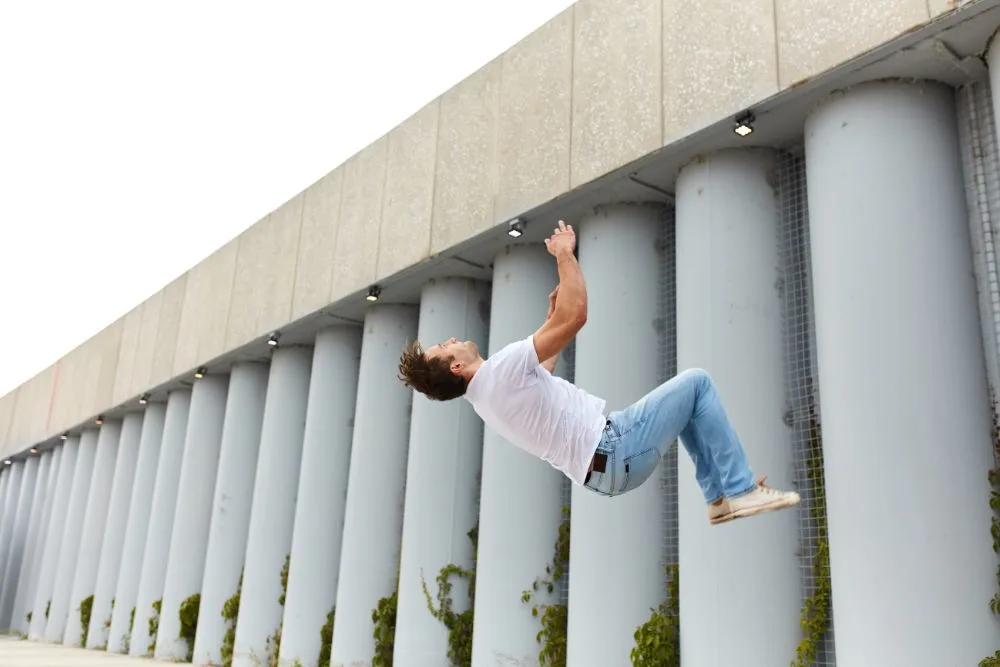Becoming a stuntman is an exciting and rewarding career path, particularly for those who thrive on adrenaline and physical challenges.

Stunt performers are essential components in the entertainment industry, as they execute dangerous tricks and feats for motion pictures and television shows that contribute to the overall narrative. Embarking on a career as a stuntman requires dedication, physical fitness, and a diverse skill set.
To get started on this thrilling journey, it’s crucial to develop physical fitness and athleticism. Typical stunt work demands a high level of physical ability, which can be achieved through participation in sports, martial arts, gymnastics, and weightlifting. Additionally, honing specialized skills like rock climbing, scuba diving, and boxing will not only improve your versatility but also make you a more attractive candidate for stunt jobs.
Building relationships with industry professionals is key to finding opportunities and recommendations for future stunt gigs. Joining a union is also a mandatory step to legally pursue stunt work in films, music videos, and television productions. With hard work, determination, and a focus on improving your skills, you’ll be well on your way to becoming a successful stuntman.

Becoming a Stuntman
Commitment and Passion
Becoming a stuntman requires a great deal of dedication and passion for the profession. This is not a career for the faint-hearted, as it involves taking on dangerous stunts and pushing your body to its limits. You must be willing to put in the time and effort to learn the necessary skills and techniques. This may involve long hours of practice, as well as constantly staying updated on industry trends and requirements.
Physical Fitness and Agility
A high level of physical fitness is crucial for a stunt performer’s success. Stunt work requires strength, endurance, flexibility, and balance. Maintaining a consistent fitness routine and working on various aspects of fitness will greatly benefit your performance as a stuntman. This could include cardio for endurance, weightlifting for strength, and stretching for flexibility.
Some fitness-related activities include:
- Running
- Swimming
- Weightlifting
- Yoga
Martial Arts and Fighting Skills
Many stunts involve fight scenes or combat sequences, making martial arts and fighting skills a natural part of a stuntman’s skill set. Knowledge of various martial art styles can increase your versatility and chances of being cast for a wider range of projects. Additionally, studying martial arts can improve your discipline, focus, and overall physical fitness.
Some popular martial arts styles for stunt work include:
- Boxing
- Brazilian Jiu-Jitsu
- Judo
- Kickboxing
- Taekwondo
Gymnastics and Parkour
Gymnastics and parkour are essential skills for many stunt performers, allowing them to perform acrobatic movements, flips, jumps, and falls with ease. These disciplines help develop spatial awareness, body control, and agility that are critical for a successful career as a stuntman. By mastering these techniques, you’ll be better equipped to perform complex stunts with grace and precision.
To improve your gymnastics and parkour skills, consider:
- Practicing at a local gym or parkour facility
- Taking classes or workshops with experienced instructors
- Joining a parkour or gymnastics group or team
In conclusion, becoming a stuntman requires a strong commitment to acquiring and refining a diverse set of physical skills, such as martial arts, gymnastics, and parkour. Additionally, staying physically fit and agile is key to ensuring a successful career in this demanding field. With passion, dedication, and hard work, you can make your dream of becoming a stuntman a reality.

Acquiring Necessary Skills
To become a successful stuntman, it’s crucial to develop a wide range of skills that will enable you to perform stunts safely and convincingly. In this section, we’ll cover some of the key areas where expertise is needed, including rock climbing and skiing, horseback riding and water skills, stunt driving and vehicle control, and stage combat and fight choreography.
Rock Climbing and Skiing
The ability to perform stunts at heights and on challenging terrain is essential for any stunt performer. Rock climbing helps by developing:
- Strength and endurance
- Coordination and balance
- Confidence when working at heights
Skiing, along with other winter sports, is also useful in the entertainment industry. Stunt performers need to be comfortable on skis and able to perform stunts at high speeds on snowy slopes. This skill development may include:
- Working on various ski terrains
- Training in challenging weather conditions
- Practicing jumps and falls on snow
Horseback Riding and Water Skills
Horseback riding is a valuable skill for stunt performers, as many action scenes in movies and television shows involve horses. Some of the key aspects to focus on when learning horseback riding include:
- Riding with confidence and control
- Jumping and falling from horses
- Stunt riding, such as standing up on a moving horse
Water skills, such as swimming and scuba diving, are essential for stunt performers who work in scenes that take place in or around water. Scuba diving certifications can help you become more marketable in the stunt industry, as they demonstrate proficiency in underwater activities.
Stunt Driving and Vehicle Control
Stunt performers often need to drive vehicles in high-pressure situations, making stunt driving and vehicle control essential skills. Some important aspects of stunt driving training include:
- Precision driving and parking
- High-speed maneuvers and drifting
- Performing jumps and rollovers with vehicles
Having experience in various types of vehicles, including motorcycles and boats, can increase your chances of getting work in the entertainment industry.
Stage Combat and Fight Choreography
Many films and television shows require stunt performers to engage in fight scenes. Therefore, stage combat and fight choreography are critical skills for aspiring stunt performers. Training in these areas might involve:
- Boxing and martial arts
- Coordinating and executing fight sequences
- Handling and using stage weapons safely
The more diverse your skillset in stage combat, the better your chances will be of finding work as a stunt performer.
Training Programs and Schools
Becoming a stuntman involves rigorous training and specialized skills. There are several training programs and schools available for aspiring stunt performers. Here, we’ll discuss a couple of these schools, including the International Stunt School and Specialized Fight and Stunt Schools.
International Stunt School
The International Stunt School offers a variety of programs for those looking to break into the industry. Their courses include a one-week Aerial Intensive Course, which provides 50 hours of advanced training in aerial skills such as:
- Wire work
- High falls
- Air ram
- Ratchet
- Rappelling
These programs cater to both new students and current stunt professionals, aiming to improve their aerial abilities.
Specialized Fight and Stunt Schools
There are numerous specialized schools focused on specific disciplines within the stunt industry. For instance, some schools focus on stage fighting, high falls, and tumbling, such as John Zimmerman’s Stunt Camp. This professional stunt training program is designed to prepare individuals for stunt performing and acting in film, theater, and live-action shows.
Similarly, institutions like Hollywood Stunts in New York City offer intensive three-week programs, covering different aspects of stunt performance, from basic falls and tumbles to advanced skills.
In summary, there are various training programs and schools to help future stuntmen develop their skills and break into the industry. The International Stunt School and specialized fight and stunt schools provide comprehensive courses for aspiring stunt performers, focusing on both general and specialized training.
Breaking into the Industry
Becoming a stuntman isn’t an overnight process. The path to a successful career in stunt work involves honing your physical skills, building a network in the entertainment industry, and taking advantage of opportunities to gain experience on film sets.
Creating a Stunt Reel
An essential step in breaking into the industry is creating a compelling stunt reel that showcases your skills and abilities as a stunt performer. A stunt reel should highlight a variety of skills, including fighting, doing acrobatic moves, and performing more unique stunts. Remember to keep the video short, focused, and professional, as directors and other industry professionals will be reviewing it when considering you for projects.
Networking and Making Connections
Another significant factor in becoming a stuntman is building connections within the entertainment industry. Many stunt performers finding work often comes down to knowing the right people. The stunt performer community requires a high level of trust, and most stunt coordinators would prefer to hire someone they know or someone who’s been recommended by a trusted colleague.
To build your network as a stunt performer, consider attending industry events, workshops, and training sessions. Joining the Screen Actors Guild (SAG-AFTRA) can also help you establish connections with other professionals in the industry. You may even want to consider working as an apprentice for an established stunt coordinator to learn from their expertise and gain valuable contacts.
Working as an Extra or Stand-In
Gaining experience on film sets is another crucial component of breaking into the industry. One way to achieve this is by working as an extra or stand-in on television and movie sets [^1^]. While this may not initially involve performing stunts, it will allow you to observe experienced stunt professionals in action and familiarize yourself with the filmmaking process.
Working on these projects can also increase your chances of joining a union, such as SAG-AFTRA. Becoming a union member can help you access better pay rates and work opportunities, as well as provide a support network for your career as a stunt performer.
In conclusion, breaking into the stunt industry requires dedication, perseverance, and a strong professional network. Aspiring stuntmen should invest time in creating an impressive stunt reel, building connections within the entertainment business, and gaining experience on film and television sets.
Working in the Field
Safety Standards and Rigging
When working as a stuntman, it’s crucial to prioritize safety. Stunt performers must adhere to stringent safety standards to avoid injury. Rigging plays a significant role in ensuring safe stunts, especially when performing high falls, aerial maneuvers, and other complex stunts. Stuntmen should master the art of safely rigging their equipment and ensuring all systems are thoroughly checked before performing a stunt. Agility and water skills are also essential for maintaining safety during stunts, including swimming and diving.
The Role of Stunt Coordinators
The stunt coordinator is a vital part of any production team, as they ensure that movie stunts are executed safely and effectively. They manage all aspects of stunts, including working with the director and actor or actress to plan and choreograph the action. A stunt double may be used to replace the actor during dangerous stunts, requiring excellent communication and coordination between all parties. Stunt coordinators are also responsible for overseeing rehearsals and ensuring that the stuntman is properly prepared and trained.
Working with Directors and Actors
Collaboration between a stuntman, the director, and actors is crucial in the world of motion picture filming. Stunt performers must understand the director’s vision and incorporate that into their performance while maintaining strict safety standards. They should be skilled in various forms of acting, as they might have to deliver lines or mimic an actor’s mannerisms.
Rehearsals play an essential role in preparing a stuntman for a scene. Working with actors helps solidify their understanding of the scene context and enables them to make any necessary adjustments, such as timing punches or rearranging choreography. It’s also crucial for a stuntman to work closely with the on-set hair and makeup team to ensure seamless integration into the scene as a stand-in or stunt double.
Navigating the Union and SAG-AFTRA
Most stunt performers are members of the Screen Actors Guild (SAG) or SAG-AFTRA, the union that represents actors and stunt professionals in the film industry. Becoming a member provides access to valuable resources, advocacy, and ensures fair pay for the performer’s work. However, joining SAG-AFTRA requires the aspiring stuntman to meet certain requirements, which may include working on a specific number of union projects or acquiring a union card.
Navigating the world of unions can be complex, but it is an essential aspect of a successful career as a stunt performer. Stunt professionals who can skillfully balance the demands of their career will be much more likely to achieve the highest level of success and recognition within the industry.
